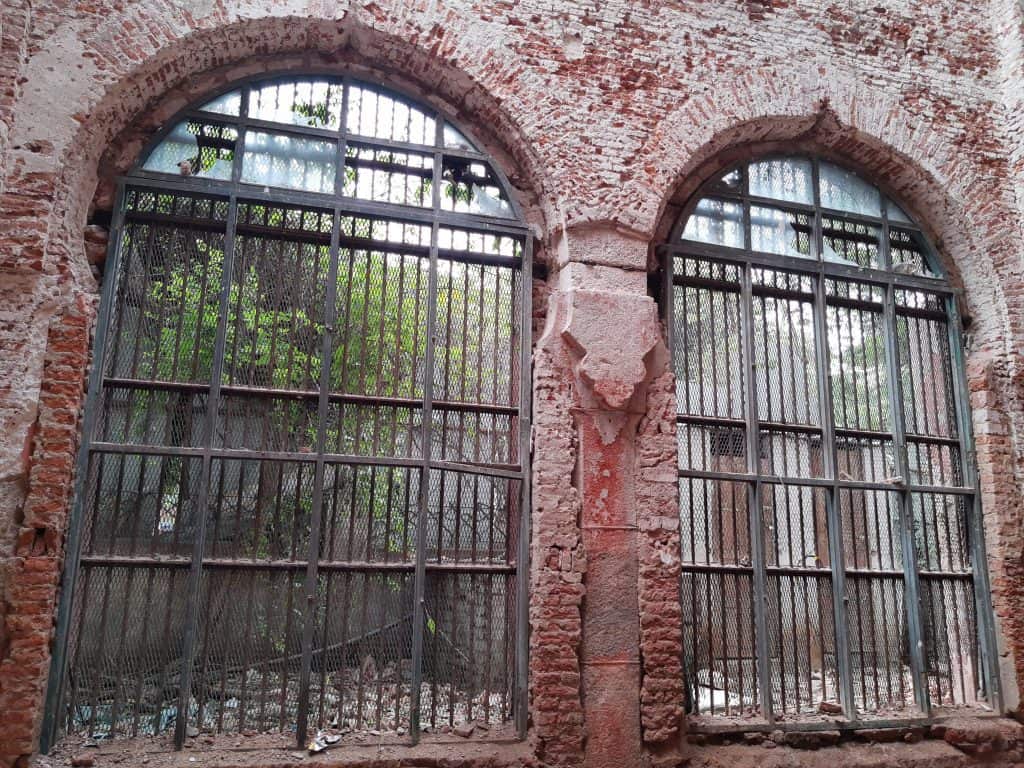It has suffered decades of neglect: languishing in dilapidated condition for years and later ravaged by fire. But, Humayun Mahal in Chepauk, the world’s first-ever building constructed in the Indo-Saracenic style of architecture, is now slated for a new lease of life.
The long, creaking sound of walls being drilled into echo across the construction site on a mid-October Friday morning. Scraping the plastering off a wall in the interior of the building, B Raju, a 49-year-old worker wipes the sweat off his face. “We are following the same traditional methods followed to construct the building over 240 years ago,” said B Raju, who has earlier worked in restoring heritage buildings in Karaikudi and Thanjavur.
Various groups are at work at the site of the mammoth restoration project: a few skilled workers mix limestone and sand, another group breaks eggs meticulously and separates the whites from the yolk and a smaller group of five workers powder whitestone, which gives out crystal sugar-like particles.

Constructed by the eighth Nawab of the Carnatic, Muhammad Ali Wallajah in 1768, Humayun Mahal and Kalas Mahal form the Chepauk Palace. Chepauk Palace was the official residence of the Nawabs till 1855.
Going back to tradition
The choice of raw materials is intriguing. It is not the usual cement, sand and bricks that you would see in any other construction site. “These raw materials used traditionally vouched for the building’s strength for centuries. We are using the same materials, after thorough research and multiple trial and errors, to regain the glory of Humayun Mahal,” said Joint Chief Engineer of PWD, K P Sathyamurthy.
He also shares several other interesting facts about the restoration:
- Madras Terrace roofing (with wood, Madras achikal brick and lime plaster) was used for the first time in the construction of Humayun Mahal. The same roofing, which can be seen on many buildings in the United Kingdom, is being used in renovation now. Even today, the brick is known as Madras brick everywhere.
- Mughal plastering technology is being used for the interiors to bring out the serene white shade. Lime, sand, whitestone, egg whites and curd are among the various raw materials used for the procedure.
- Once the plastering is done, it has to be scraped with a piece of granite stone for at least three days.
Challenges
There are four key aspects of the restoration procedure that call for focus: the source of raw materials, skilled labour, timing and application.
| Raw material | Source |
| Sand | Cauvery River |
| Whitestone | Rajapalayam and Rajasthan |
| Limestone | Virudhu Nagar |
| Curd | Chengalpet and Tiruttani |
| Granite stone | Hilly regions of Rajapalyam |
| Square tiles | Tirunelveli |
“Procuring raw materials of the highest quality is important. There is a specific time when the mixture is to be applied and a procedure to be followed for that. Only skilled labour would adhere to those norms,” explained the senior PWD official.
However, manpower is a huge challenge. “I earn peanuts as a construction worker. But I did not quit since it is my passion to work on old buildings. Not everyone will think this way,” said Raju. A lot of workers have migrated to countries such as Dubai and Saudi Arabia for better opportunities.
Once renovated, Humayun Mahal, just like any other heritage building in Chennai, will house a number of government departments. Not just history buffs, but even lay citizens of Chennai are looking forward to visiting the renovated structure. Every corner of the building holds slices of the past and each brick has a tale to narrate.
Meanwhile, here are some shots of the ongoing renovation work:

in egmore court complex govt constructed new building at a cos of 16 crores housing about 12 court and several offices and also renovated the old court building at a cost of five crores housing for three court. new building was constructed and opened even after about one year of opening the new court the heritage building work is not over. on enquiry it was informed only plumbing works are pending for want of funds. nobody knows when it will be over but now the five crore spent building is lying without proper maintenance. who will take responsibility for the unnecessary delay.